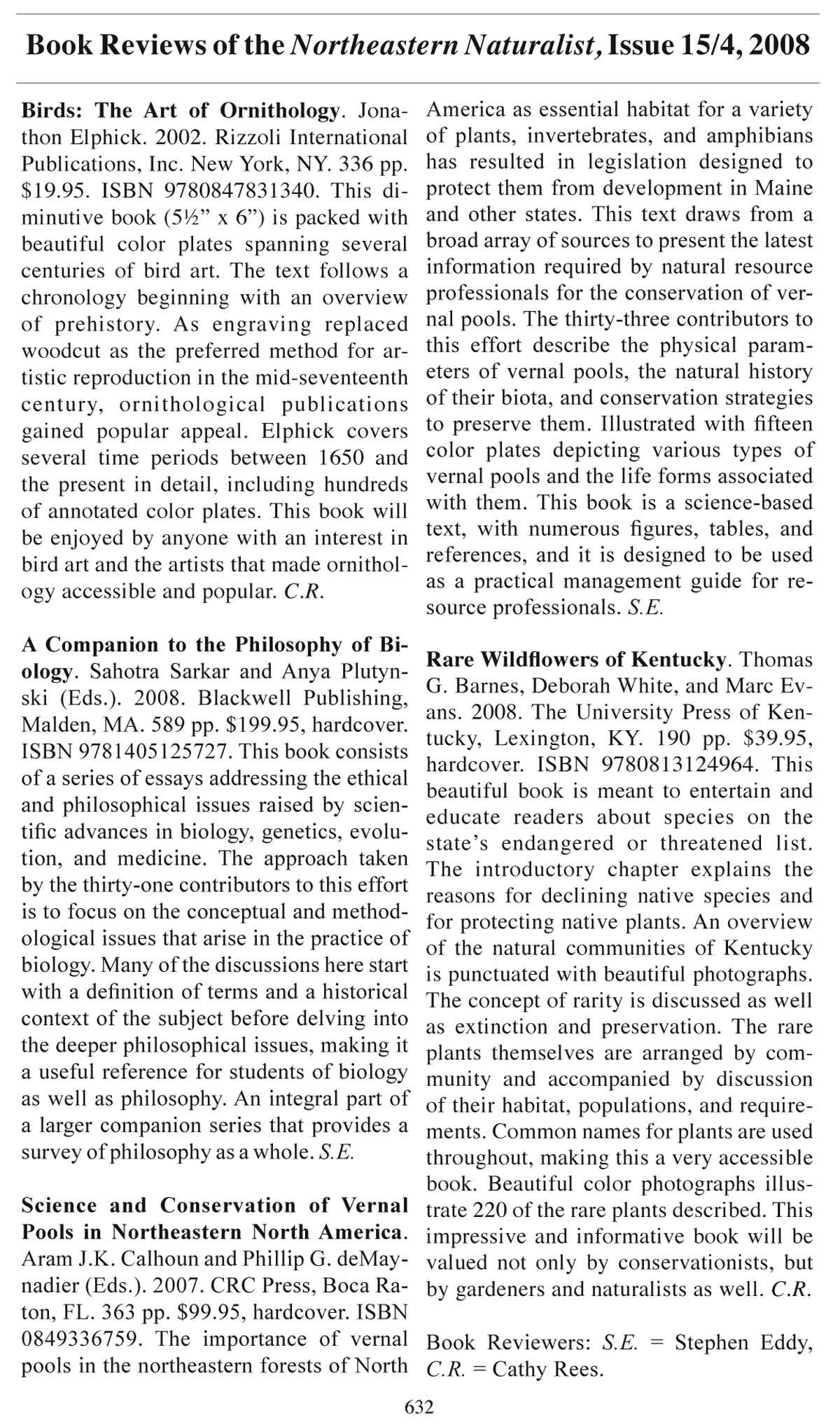Access Journal Content
Open access browsing of table of contents and abstract pages. Full text pdfs available for download for subscribers.
Current Issue: Vol. 30 (3)

Check out NENA's latest Monograph:
Monograph 22









632 Northeastern Naturalist Vol. 15, No.4
632
Book Reviews of the Northeastern Naturalist, Issue 15/4, 2008
Birds: The Art of Ornithology. Jonathon
Elphick. 2002. Rizzoli International
Publications, Inc. New York, NY. 336 pp.
$19.95. ISBN 9780847831340. This diminutive
book (5½” x 6”) is packed with
beautiful color plates spanning several
centuries of bird art. The text follows a
chronology beginning with an overview
of prehistory. As engraving replaced
woodcut as the preferred method for artistic
reproduction in the mid-seventeenth
century, ornithological publications
gained popular appeal. Elphick covers
several time periods between 1650 and
the present in detail, including hundreds
of annotated color plates. This book will
be enjoyed by anyone with an interest in
bird art and the artists that made ornithology
accessible and popular. C.R.
A Companion to the Philosophy of Biology.
Sahotra Sarkar and Anya Plutynski
(Eds.). 2008. Blackwell Publishing,
Malden, MA. 589 pp. $199.95, hardcover.
ISBN 9781405125727. This book consists
of a series of essays addressing the ethical
and philosophical issues raised by scientific advances in biology, genetics, evolution,
and medicine. The approach taken
by the thirty-one contributors to this effort
is to focus on the conceptual and methodological
issues that arise in the practice of
biology. Many of the discussions here start
with a definition of terms and a historical
context of the subject before delving into
the deeper philosophical issues, making it
a useful reference for students of biology
as well as philosophy. An integral part of
a larger companion series that provides a
survey of philosophy as a whole. S.E.
Science and Conservation of Vernal
Pools in Northeastern North America.
Aram J.K. Calhoun and Phillip G. deMaynadier
(Eds.). 2007. CRC Press, Boca Raton,
fl. 363 pp. $99.95, hardcover. ISBN
0849336759. The importance of vernal
pools in the northeastern forests of North
America as essential habitat for a variety
of plants, invertebrates, and amphibians
has resulted in legislation designed to
protect them from development in Maine
and other states. This text draws from a
broad array of sources to present the latest
information required by natural resource
professionals for the conservation of vernal
pools. The thirty-three contributors to
this effort describe the physical parameters
of vernal pools, the natural history
of their biota, and conservation strategies
to preserve them. Illustrated with fifteen
color plates depicting various types of
vernal pools and the life forms associated
with them. This book is a science-based
text, with numerous figures, tables, and
references, and it is designed to be used
as a practical management guide for resource
professionals. S.E.
Rare Wildflowers of Kentucky. Thomas
G. Barnes, Deborah White, and Marc Evans.
2008. The University Press of Kentucky,
Lexington, KY. 190 pp. $39.95,
hardcover. ISBN 9780813124964. This
beautiful book is meant to entertain and
educate readers about species on the
state’s endangered or threatened list.
The introductory chapter explains the
reasons for declining native species and
for protecting native plants. An overview
of the natural communities of Kentucky
is punctuated with beautiful photographs.
The concept of rarity is discussed as well
as extinction and preservation. The rare
plants themselves are arranged by community
and accompanied by discussion
of their habitat, populations, and requirements.
Common names for plants are used
throughout, making this a very accessible
book. Beautiful color photographs illustrate
220 of the rare plants described. This
impressive and informative book will be
valued not only by conservationists, but
by gardeners and naturalists as well. C.R.
Book Reviewers: S.E. = Stephen Eddy,
C.R. = Cathy Rees.












 The Northeastern Naturalist is a peer-reviewed journal that covers all aspects of natural history within northeastern North America. We welcome research articles, summary review papers, and observational notes.
The Northeastern Naturalist is a peer-reviewed journal that covers all aspects of natural history within northeastern North America. We welcome research articles, summary review papers, and observational notes.